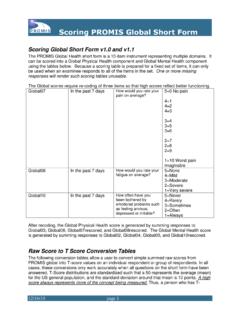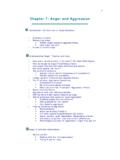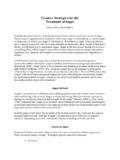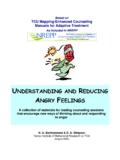Transcription of ANGER - Assessment Center
1 ANGER . A brief guide to the PROMIS ANGER instruments: ADULT PEDIATRIC PARENT PROXY. PROMIS Item Bank ANGER PROMIS Pediatric Short Form PROMIS Parent Proxy Short Form PROMIS Item Bank ANGER ANGER 5a ANGER 5a PROMIS Short Form ANGER 5a PROMIS Pediatric Short Form PROMIS Short Form ANGER 8a ANGER 6a ABOUT ANGER . The PROMIS ANGER instruments measure self-reported angry mood (irritability, frustration), negative social cognitions (interpersonal sensitivity, envy, disagreeableness), and efforts to control ANGER . Often associated with episodes of frustration that impede goal-directed behavior, ANGER is marked by attitudes of hostility and cynicism. Specific components relate to verbal and non-verbal evidence of ANGER . Physical aggression items are not included. The ANGER short form is universal rather than disease-specific. It assesses ANGER over the past seven days. ANGER instruments are available for adults (ages 18+), pediatric self-report (ages 8-17) and for parents serving as proxy reporters for their child (youth ages 5-17).
2 (For complete definition see ). INTRODUCTION TO Assessment OPTIONS. There are two administration options for assessing ANGER : short forms and computerized adaptive test (CAT). When administering a short form, instruct participants to answer all of the items ( , questions or statements). presented. With CAT, participant responses guide the system's choice of subsequent items from the full item bank (22 items in total). Although items differ across respondents taking CAT, scores are comparable across participants. Some administrators may prefer to ask the same question of all respondents or of the same respondent over time, to enable a more direct comparability across people or time. In these cases, or when paper administration is preferred, a short form would be more desirable than CAT. This guide provides information on all ANGER short form and CAT instruments. Whether one uses a short form or CAT, the score metric is Item Response Theory (IRT), a family of statistical models that link individual questions to a presumed underlying trait or concept of ANGER represented by all items in the item bank.
3 When choosing between CAT and a short form, it is useful to consider the demands of computer-based Assessment , and the psychological, physical, and cognitive burden placed on respondents as a result of the number of questions asked. Some PROMIS domains have multiple versions of instruments ( Item Banks/Computerized Adaptive Tests (CATs) and Short Forms). Generally, it is recommended that you use the most recent version available which can be identified as the instruments with the highest version number. 9/22/2015 PROMIS ANGER Page 1. Instruments are changed for various reasons. For example, the original PROMIS Bank version Physical Function included 124 items after being tested in a diverse sample. Later, during an effort to translate instrument items into multiple languages, translation challenges were identified. Therefore, minor modifications to the English source items were required ( metric equivalents to measurements such as Over 10 pounds/ 5 kg were added). These modifications (19 in total) resulted in the creation of a version item bank.
4 Later, version was created by eliminating two items due to restrictions in their use. In most cases, an instrument that has a decimal increase ( to or ) retains the same item-level parameters as well as instrument reliability and validity. In cases where a version number increases by a whole number ( , to ), the changes to the instrument are more substantial. For example, the PROMIS Bank Satisfaction with Participation in Social Roles is a small item bank comprised of 14 role function items. While the PROMIS Bank Satisfaction with Social Roles and Activities instrument includes a broader range of item content. Version was re-calibrated independent of version , and is a larger (44 items), superior item bank. Details on the specific differences between instrument versions can be found in scoring manuals available on the Assessment Center homepage. SELECTING A PEDIATRIC OR PARENT PROXY INSTRUMENT. In selecting whether to use the pediatric or parent proxy instrument for this domain, it is important to consider both the population and the domain which you are studying.
5 Pediatric self-report should be considered the standard for measuring patient-reported outcomes among children. However, circumstances exist when the child is too young, cognitively impaired, or too ill to complete a patient-reported outcome instrument. While information derived from self-report and proxy-report is not equivalent, it is optimal to assess both the child and the parent since their perspectives may be independently related to healthcare utilization, risk factors, and quality of care. WHICH CALIBRATION SAMPLE SHOULD I USE? The PROMIS Parent Proxy instruments have two calibration samples Parent Proxy and Parent Proxy without Local Dependence. The former includes calibrations for all items. This is the default calibration sample. If you aren't sure which calibration sample to use, utilize this one. The Parent Proxy without Local Dependence does not include calibrations for some items. When using the Scoring Service, use the default calibration sample ( , Parent Proxy ).
6 Other calibration samples may exist from past research. SCORING THE INSTRUMENT. Short Forms: PROMIS instruments are scored using item-level calibrations. This means that the most accurate way to score a PROMIS instrument is to utilize scoring tools within Assessment Center or API that look at responses to each item for each participant. Data collected in either of these platforms will automatically score in this way. We refer to this as response pattern scoring. Response pattern scoring can be used when data was collected on paper or in another software package through the Assessment Center Scoring Service. Because response pattern scoring is more accurate than the use of raw score/scale score look up tables, it is 9/22/2015 PROMIS ANGER Page 2. preferred. However, if you aren't able to use response pattern scoring, you can use the instructions below which rely on raw score/scale score look-up tables. For adults, each question has five response options ranging in value from one to five (for pediatrics and parent proxy it is 0 to 4).
7 To find the total raw score for a short form with all questions answered, sum the values of the response to each question. For example, for the adult 5-item form, the lowest possible raw score is 5; the highest possible raw score is 25 (see all short form scoring tables in Appendix 1). A score can be approximated if a participant skips a question. If items are missing, first check how many items were answered. For short forms with at least 5 items, confirm that 4 or 50% of items, whichever is greater, were answered. For example, a 4-item short form can only be scored with complete data. A 5-item short form can be scored as long as 4 items were answered. A 10-item short form can be scored as long as the participant answered at least 5 items. For branched instruments ( , Alcohol Use), the screening question is not used in calculating the score and therefore shouldn't be counted when assessing if the minimum number of items were answered. After confirming that enough responses were provided, sum the response scores from the items that were answered (not including any screening question).
8 Multiply this sum by the total number of items in the short form. Finally, divide by the number of items that were answered. For example, if a respondent answered 5 of 8 questions and answered all items with the second lowest response option (2), you would sum all responses (10), multiply by the number of items in the short form (8) and divide by the number of items that were answered (5). Here (10x8)/5=16. If the result is a fraction, round up to the nearest whole number. This is a pro-rated raw score. Again, the formula is: (Raw sum x number of items on the short form). Number of items that were actually answered Locate the applicable score conversion table in Appendix 1 and use this table to translate the total raw score or pro-rated score into a T-score for each participant. The T-score rescales the raw score into a standardized score with a mean of 50 and a standard deviation (SD) of 10. Therefore a person with a T-score of 40 is one SD below the mean. It is important to note that Assessment Center will convert a participant's pattern of responses to a standardized T-score after they have finished a CAT.
9 The standardized T-score is reported as the final score for each participant. For the adult PROMIS ANGER 5a short form, a raw score of 10 converts to a T-score of with a standard error (SE) of (see scoring table for the 5a short form in Appendix 1). Thus, the 95% confidence interval around the observed score ranges from to (T-score + ( *SE) or + ( * ). For pro-rated scores, this calculation assumes that responses are missing at random. This isn't always true. Therefore, use caution when interpreting the final pro-rated T-score. CAT: A minimum number of items (4 for adult CATs and 5 for Peds and Parent Proxy CATs) must be answered in order to receive a score for ANGER CAT. The first item is selected because it provides the most information about the general population. The response to this item will guide the system's choice of the next item for the participant. The participant's response to this item will dictate the selection of the following question, and so on. As additional items are administered, the potential for error is reduced and confidence in the respondent's score 9/22/2015 PROMIS ANGER Page 3.)
10 Increases. CAT will continue until either the standard error drops below a specified level, or the participant has answered the maximum number of questions (12), whichever occurs first. For most PROMIS instruments, a score of 50 is the average for the United States general population with a standard deviation of 10 because calibration testing was performed on a large sample of the general population. However, pediatric and parent proxy short forms were not calibrated on a national sample and so a score of 50. represents the average of the calibration sample which was generally more enriched for chronic illness. As these instruments, a score of 50 likely represents somewhat sicker people than the general population. The T-score is provided with an error term (Standard Error or SE). The Standard Error is a statistical measure of variance and represents the margin of error for the T-score. Important: A higher PROMIS T-score represents more of the concept being measured. For negatively-worded concepts like ANGER , a T-score of 60 is one SD worse than average.









